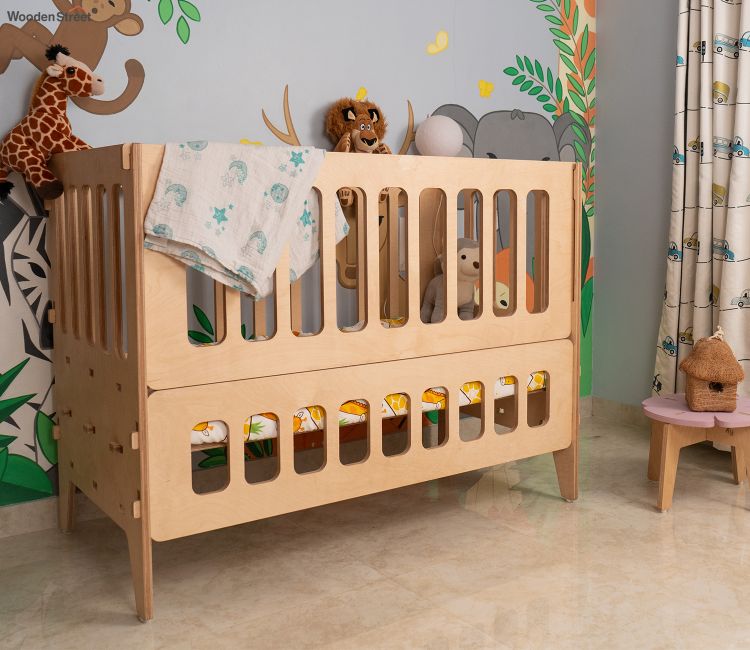How to Select a Safe and Comfortable Baby Bed
Introduction
Choosing the right bed for your baby is one of the most important decisions new parents face. Not only does it provide your little one with a safe space to sleep, but it also sets the foundation for healthy sleeping habits. Ensuring both comfort and safety is key to your baby’s well-being. In this article, we will explore various types of baby beds, essential safety features, and tips on how to make your baby’s bed as comfortable as possible.

Types of Baby Beds
1.1 Cribs
Cribs are the most common and long-term option for babies. A traditional crib provides a safe space for your child to sleep from infancy through toddlerhood. Some cribs are convertible, meaning they can be transformed into toddler beds, daybeds, or even full-sized beds as your child grows. These types of cribs offer versatility and long-term use, though they tend to take up more space than other options.
1.2 Bassinets
Bassinets are ideal for newborns, offering a compact, cozy, and portable sleep option. Many parents choose bassinets because they can keep them close to the bed, making nighttime feeding and monitoring easier. Unlike cribs, bassinets are small and portable, though they are typically only suitable for the first few months until your baby starts to roll or push up.
1.3 Co-Sleepers
Co-sleeping is a common preference for parents who want to keep their baby as close as possible. Co-sleeper beds allow the baby to sleep right next to you while having their own separate space. Side sleepers, which attach to your bed, and bedside cribs are popular types of co-sleepers. It’s important to research the pros and cons of co-sleepers, as there are differing opinions on their safety. Always ensure that the co-sleeper you choose follows the latest safety regulations.
1.4 Travel Cribs & Portable Beds
For families on the go, travel cribs and portable baby beds offer flexibility. They are lightweight, foldable, and easy to carry, making them great for vacations or family visits. Safety should remain a priority when choosing portable beds, so be sure to select one with a stable frame, secure locking mechanisms, and a firm mattress.
Key Safety Features to Look For
2.1 Sturdy Construction
Your baby’s bed must have a solid frame and be constructed from durable materials. Ensure that the bed doesn’t wobble or creak, as this could indicate instability. Wooden or metal cribs tend to be the most durable options.
2.2 Mattress Safety
A firm mattress is essential for baby’s safety to reduce the risk of sudden infant death syndrome (SIDS). The mattress should fit snugly into the crib or bassinet with no more than two fingers' width between the mattress and the crib walls. Avoid using soft mattresses, memory foam, or add-on mattress pads that could pose suffocation risks.
2.3 Compliance with Safety Standards
Always look for beds and cribs that comply with recognized safety standards, such as those set by the Juvenile Products Manufacturers Association (JPMA) or the American Society for Testing and Materials (ASTM). Avoid purchasing or using outdated cribs with drop sides, as they have been banned for safety concerns.
2.4 Slat and Corner Post Design
When choosing a crib, ensure the slats are spaced no more than 2 3/8 inches apart to prevent the baby’s head from getting stuck. The corner posts should be flush with the top rail or very tall to avoid catching clothing or other items, which could cause accidents.
Ensuring Comfort for Your Baby
3.1 Mattress Comfort
While safety is a top priority, comfort matters too. Opt for a breathable, hypoallergenic mattress cover that keeps the baby cool and prevents overheating. Memory foam should be avoided in baby beds, as it is too soft for infants and may pose safety risks.
3.2 Bedding Considerations
Use fitted sheets specifically designed for your crib or bassinet mattress. The bedding should be light and breathable to prevent overheating. Avoid placing pillows, quilts, or crib bumpers in the crib, as they can increase the risk of suffocation. Stick to breathable fabrics like cotton for the baby’s comfort.
3.3 Temperature Regulation
Maintaining a comfortable temperature is key for restful sleep. Ensure the room is cool enough for the baby, between 68°F and 72°F (20°C to 22°C), and dress the baby appropriately for the season. Layering with breathable fabrics, such as a light sleep sack or swaddle, helps keep your baby comfortable without the need for heavy blankets.
Additional Features to Consider
4.1 Adjustable Mattress Heights
Many cribs come with adjustable mattress heights, which are useful for parents as the baby grows. For newborns, you can place the mattress at a higher level for easier access. As the baby begins to sit and stand, the mattress can be lowered to prevent falls.
4.2 Portability and Mobility
Wheeled cribs or bassinets offer added convenience, allowing you to easily move the bed from one room to another. If you’re short on space, a compact or foldable crib might be the best option.
4.3 Aesthetic and Practical Design
You may also want to consider the design of the baby bed. It’s possible to find cribs and bassinets that match your nursery’s theme while still being functional. Some cribs even offer built-in storage for baby essentials, making it easier to keep things organized.
Conclusion
Selecting a safe and comfortable baby bed requires careful consideration of safety features, comfort, and your family’s specific needs. Whether you opt for a crib, bassinet, or co-sleeper, always prioritize beds that meet safety standards and provide a stable, secure sleep environment. Pair this with a comfortable, firm mattress and appropriate bedding to ensure your baby gets the best sleep possible. By making informed decisions, you’ll create a sleeping space that fosters both safety and sweet dreams for your little one.




Comments